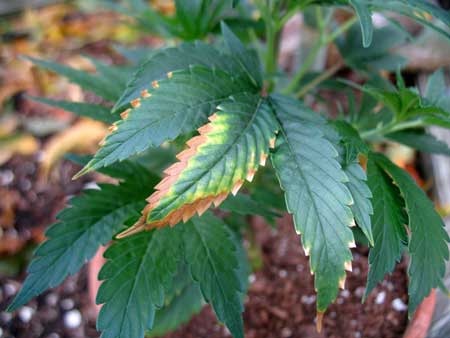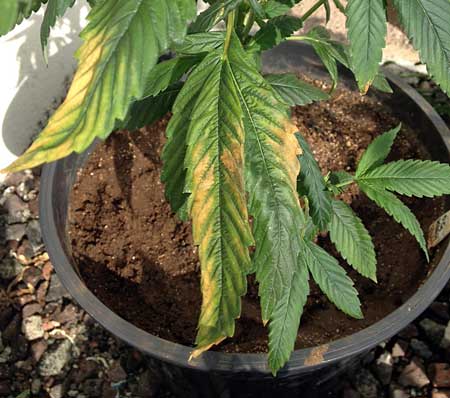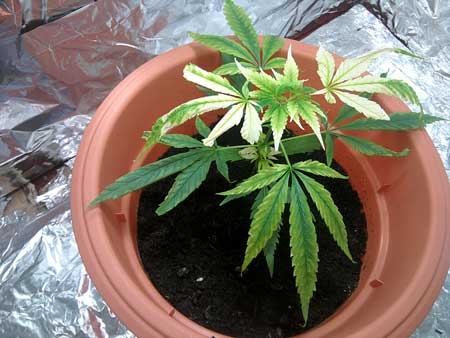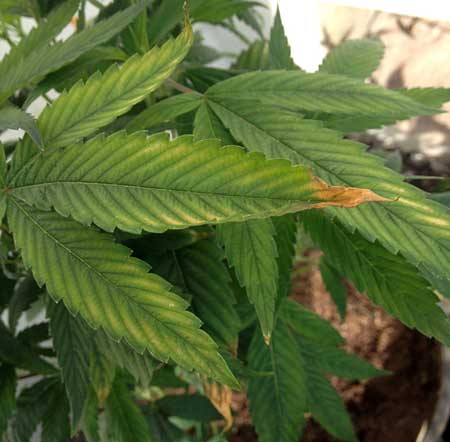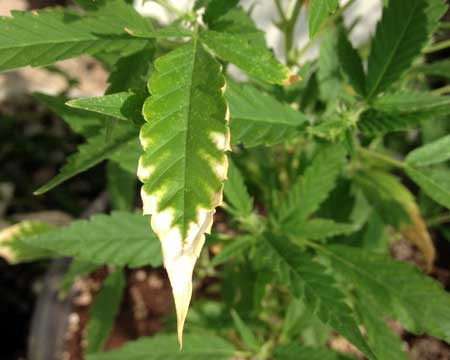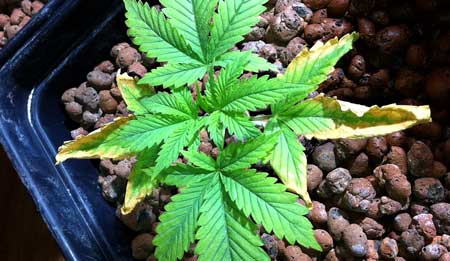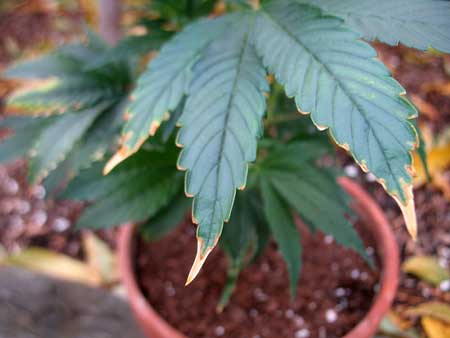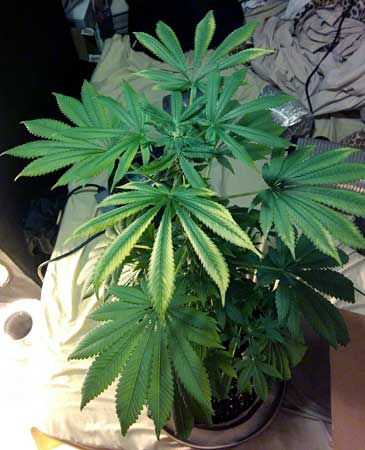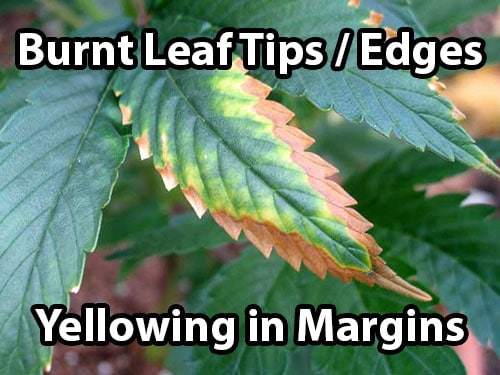
by Nebula Haze
What Does a Cannabis Potassium Deficiency Look Like?
Leaf Problem / Symptoms: With a marijuana potassium deficiency, you’ll generally see symptoms on older leaves, but not always. Sometimes you’ll see the symptoms at the top of the plant. Leaves with a potassium deficiency get yellow, brown, or burnt edges and tips. The burnt edges may look a little like nutrient burn, except the affected leaves also start turning yellow in the margins.
Example of a marijuana potassium deficiency with common leaf symptoms
You may see the brown burnt edges first, or you may see the yellowing first. When the leaf symptoms are both present, it’s a good sign you have a potassium deficiency in your leaves.
Plants may stretch and stems may become weak, but leaf symptoms are more noticeable. The leaf symptoms appear somewhat similar to an iron deficiency in that they can turn bright yellow, but the tips of the leaves curl as the edges turn brown, burn and die.
Cannabis potassium deficiencies can cause your cannabis leaves to turn white, yellow, brown or burnt looking, but the inside veins almost always stay green. Sometimes a Potassium deficiency is made worse by overwatering, as was the case with this plant.
Sometimes you’ll get something that looks a lot like tip burn with a potassium deficiency, but it goes in further than nutrient burn, and with a potassium deficiency you also see yellowing between the leaf margins
Sometimes the burn can appear pale, bleached or yellow, instead of brown. If you look in the background of this pic, you can see some of the leaves have turned brown in addition to the bright yellow leaf in the front. These are all signs of a marijuana potassium deficiency.
Potassium deficiencies are commonly mistaken for other nutrient problems!
Sometimes the first symptoms of a cannabis potassium deficiency look a lot like nutrient burn. One difference is the edges of the leaves will also start turning brown, where nutrient burn usually only affects the tips. And unlike with nutrient burn the leaves of a potassium deficiency turn yellow in the margins, especially near the burn edges.
This is not nutrient burn, it’s actually the first stage of potassium deficiency!
Could it actually be light burn?
Keeping your grow lights too close, for example with powerful LEDs and HPS grow lights can give your plants “sunburn” even if the temperature is cool! This can sometimes look like exactly like a cannabis potassium deficiency when the true problem is your grow lights are too close to your leaves.
These leaves look like they have a potassium deficiency but the symptoms are actually caused by light burn (grow lights being kept too close)
Solution for Potassium Deficiency in Cannabis
Note: Sometimes a cannabis potassium deficiency (like all deficiencies) can be triggered by stressful conditions (for example overwatering, heat, transplant, etc) and may clear up on its own after the period of stress is over. If you only see one or two affected leaves near the bottom of the plant, and the problem isn’t spreading, I wouldn’t worry too much about it!
1.) Make Sure It’s Not Light Burn
When a cannabis plant is kept too close to the grow lights, it can get light burn which looks almost exactly like a potassium deficiency. If you’re using powerful lights like an LED or MH/HPS, consider moving the light away a few inches further away to see if that stops the problem from spreading. LEDs or MH/HPS should never be kept closer than 12″ away, and most models should be kept further. How far away do I keep my grow lights?
Learn more about cannabis light burn
2.) Use Good Sources of Nutrients
Most cannabis growers don’t need to add more nutrients if their leaves are experiencing a nutrient deficiency. In fact, most growers have actually already given plenty of potassium to their cannabis plants, whether they meant to or not. If you’re using quality soil or cannabis-friendly nutrients, you probably don’t need to worry about adding more patassium.
Potassium deficiencies are generally more likely to appear when a grower is using heavily filtered or reverse osmisis (RO) water to feed plants, but as long as you’re giving your plants a good source of nutrients, you probably need to…
3.) Adjust pH to Correct Range
But the reason most growers see potassium deficiencies is because potassium is best absorbed at lower pH ranges. When the pH gets too high, your plant may exhibit signs of a potassium deficiency even if it’s physically there near the roots.
Learn how to manage your pH when growing cannabis.
In soil, potassium is best absorbed by the roots in the 6.0 – 7.0 pH range
In hydro or coco coir, potassium is best absorbed by the roots in the 5.5 – 6.5 pH range
4.) Watch Leaves for Recovery
If you suspect your growing cannabis plant has a potassium deficiency, flush your system with clean, pH’d water that contains a regular dose of cannabis-friendly nutrients. Old damaged growth will likely not recover. Watch plant over next few days to make sure that the problem stops spreading to new growth.
If you cannot get rid of your potassium deficiency and want to look at more pictures of cannabis leaf symptoms…

